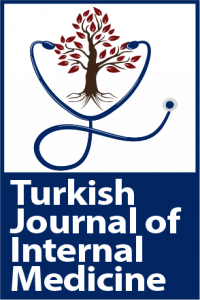Evaluation of Insulinoma Cases Presented with Hyperinsulinemic Hypoglycemia: A single-centre Experience
Evaluation of Insulinoma Cases Presented with Hyperinsulinemic Hypoglycemia: A single-centre Experience
Insulinoma, hyperinsulinism, hypoglycemia, neuroendocrine tumor,
___
- Service FJ, McMahon MM, O’Brien PC, Ballard DJ. Functioning insulinoma—incidence, recurrence, and long-term survival of patients: A 60-year study. Mayo Clin Proc. 1991 Jul;66(7):711-9. doi: 10.1016/S0025-6196(12)62083-7.
- Cryer PE, Axelrod L, Grossman AB, Heller SR, Montori VM, Seaquist ER, Service FJ. Evaluation and management of adult hypoglycemic disorders: An endocrine society clinical practice guideline. J Clin Endocrinol Metab. 2009 Mar;94(3):709-28. doi: 10.1210/jc.2008-1410.
- Okabayashi T, Shima Y, Sumiyoshi T, Kozuki A, Ito S, Ogawa Y, Kobayashi M, Hanazaki K. Diagnosis and management of insulinoma. World J Gastroenterol. 2013 Feb 14;19(6):829-37. doi: 10.3748/wjg.v19.i6.829.
- Brandi ML, Agarwal SK, Perrier ND, Lines KE, Valk GD, Thakker R v. Multiple endocrine neoplasia type 1: Latest insights. Endocr Rev. 2021 Mar 15;42(2):133-70. doi: 10.1210/ endrev/bnaa031.
- Liao J, Ding F, Luo W, Nie X, He Y, Li G. Using the secretion ratios of insulin and c-peptide during the 2-h oral glucose tolerance test to diagnose insulinoma. Dig Dis Sci. 2021 May;66(5):1533-9. doi: 10.1007/s10620-020-06379-z.
- Yang Y, Shi J, Zhu J. Diagnostic performance of noninvasive imaging modalities for localization of insulinoma: A meta- analysis. Eur J Radiol. 2021 Dec;145:110016. doi: 10.1016/j. ejrad.2021.110016.
- Sho H, Fukui K, Yoneda S, Toyoda S, Ozawa H, Ishibashi C, Fujita Y, Eguchi H, Kozawa J, Shimomura I. Insulinoma induces a hyperinsulinemia-mediated decrease of GLUT2 and GLP1 receptor in normal pancreatic β-cells. Biochem Biophys Res Commun. 2021 Jan 1;534:702-6. doi: 10.1016/j. bbrc.2020.11.014.
- GuW,LiuY,LiuH,YangG,GuoQ,DuJ,JinN,ZangL,Lv Z, Ba J, Mu Y, Dou J. Characteristics of glucose metabolism indexes and continuous glucose monitoring system (CGMS) in patients with insulinoma. Diabetol Metab Syndr. 2017 Mar 14;9:17. doi: 10.1186/s13098-017-0215-3.
- Lewis MA, Thompson GB, Young WF. Preoperative assessment of the pancreas in multiple endocrine neoplasia type 1. World J Surg. 2012 Jun;36(6):1375-81. doi: 10.1007/s00268-012-1539-7.
- Maggio I, Mollica V, Brighi N, Lamberti G, Manuzzi L, Ricci AD, Campana D. The functioning side of the pancreas: a review on insulinomas. J Endocrinol Invest. 2020 Feb;43(2):139-48. doi: 10.1007/s40618-019-01091-w.
- Placzkowski KA, Vella A, Thompson GB, Grant CS, Reading CC, Charboneau JW, Andrews JC, Lloyd R v., Service FJ. Secular trends in the presentation and management of functioning insulinoma at the mayo clinic, 1987-2007. J Clin Endocrinol Metab. 2009 Apr;94(4):1069-73. doi: 10.1210/ jc.2008-2031.
- Falconi M, Eriksson B, Kaltsas G, Bartsch DK, Capdevila J, Caplin M, Kos-Kudla B, Kwekkeboom D, Rindi G, KlÖppel G, Reed N, Kianmanesh R, Jensen RT. ENETS consensus guidelines update for the management of patients with functional pancreatic neuroendocrine tumors and non-functional pancreatic neuroendocrine tumors. Neuroendocrinology. 2016;103(2):153-71. doi: 10.1159/000443171.
- Belfiori G, Wiese D, Partelli S, Wächter S, Maurer E, Crippa S, Falconi M, Bartsch DK. Minimally invasive versus open treatment for benign sporadic insulinoma comparison of short-term and long-term outcomes. World J Surg. 2018 Oct;42(10):3223-30. doi: 10.1007/s00268-018-4628-4.
- Ahmadi P, Shirzad N, Shahsiah R, Hemmatabad M. Insulinoma: spectrum of clinicopathological features in a tertiary center. Istanbul Medical Journal. 2021;22(1):61-7. doi: 10.4274/imj. galenos.2021.45202.
- Ülkü A, Yalav O, Sarıtaş AG, Rencüzoğulları A, Dalcı K, Eray İC, Yağmur Ö, Akcam AT. Long-term outcomes of surgical management of insulinoma: Single Center Experience. Dicle Medical Journal. 2018;45(2):139-46. doi: 10.5798/ dicletip.424975.
- Pekalay Z. Bir seri insülinoma olgusu: On hastadaki deneyimimiz. Turk J Endocrinol Metab. 2017;21(3):85-8. doi: 10.25179/tjem.2017-56483.
- Başlangıç: 2019
- Yayıncı: Nizameddin KOCA
Retrospective Evaluation of the Efficiency of Therapeutic Plasmapheresis in Thyrotoxic Patients
Filiz MERCAN SARIDAŞ, Tugce ZOR TURNA, Ensar AYDEMİR, Coşkun ATEŞ, Erhan HOCAOĞLU, Soner CANDER, Özen ÖZ GÜL, Fahir ÖZKALEMKAŞ, Erdinç ERTÜRK, Canan ERSOY
Indomethacin induced toxic hepatitis: a case report
Orkun SAKAR, Tufan TEKER, Selim Giray NAK, Nesrin UĞRAŞ
Erhan HOCAOĞLU, Ensar AYDEMİR, Coşkun ATEŞ, Filiz MERCAN SARIDAŞ, Omer Fatih NAS, Mehmet Fatih İNECİKLİ, Soner CANDER, Özen ÖZ GÜL, Erdinç ERTÜRK, Canan ERSOY
A finding that is not clear what will emerge when you see it: Hypoalbuminemia
Miraç VURAL KESKİNLER, Ertunç ŞİMDİ, Ender İĞNECİ
Ercan PESEN, Celaleddin DEMİRCAN, Deniz SIĞIRLI
Nasal Cavity Neuroendocrine Carcinoma and Synchronous Breast Cancer: A Case Report
Asuman Şebnem HACIMUSTAFAOĞLU, Adem DELİGÖNÜL
Colchicine Intoxication: A Case Report
Aytül COŞAR ERTEM, Mert ŞAHİN, Muge SAHIN
A Rare Cause of Hypokalemia: Ectopic ACTH Syndrome
Merve TEKİNYILDIZ, Sanem KAYHAN, Murat ÇALAPKULU, Rıdvan ÖZKAN, İbrahim AKDAĞ
Development of AA Amyloidosis in a Patient with Psoriasis: A Case Report
Mehmet SEZEN, Müge ŞAHİN, Abdülmecit YILDIZ, Ayşegül ORUÇ, Saide GÜLLÜLÜ, Mahmut YAVUZ, Mustafa GÜLLÜLÜ, Kamil DİLEK, Alparslan ERSOY
